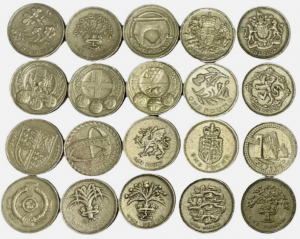The round £1 coin, often simply called the round pound, was a familiar part of daily life in the UK for more than three decades. First issued in 1983, it replaced the old £1 note and quickly became one of the most commonly used coins in circulation. Over the years, the round pound underwent numerous design changes, became a target for counterfeiters, and was eventually replaced by the 12-sided £1 coin in 2017. This article looks at the full history of the coin — from its introduction to its withdrawal — and why millions of people still have old £1 coins hidden away today.
The Introduction of the £1 Coin
In the early 1980s, the Bank of England decided that the £1 note was too costly to produce and had too short a lifespan. On average, a paper note lasted just a few months before becoming worn and needing replacement. Coins, however, could last for decades.
As a result, the £1 coin was introduced in April 1983. The new coin was round, made from nickel-brass, and weighed 9.5 grams. Its golden colour and solid weight gave it a distinct look and feel compared to other UK coins.
Designs of the Round Pound
One of the most interesting features of the £1 coin was the variety of reverse designs issued over the years. More than 20 different designs were released, many celebrating the four nations of the United Kingdom. Examples included:
-
1985 & 1990 – Welsh leek
-
1986 & 1991 – Scottish thistle
-
1988 & 1993 – English oak tree
-
1990 & 1995 – Northern Irish flax plant
-
2004–2007 – Bridges series, showcasing iconic bridges in each UK nation
-
2010–2011 – Coat of arms series, featuring national symbols of England, Wales, Scotland, and Northern Ireland
The obverse side (the “heads”) always featured the profile of Queen Elizabeth II, though her portrait was updated over the decades to reflect her changing appearance.
Counterfeiting Problems
By the mid-2000s, the round pound had developed a serious problem: counterfeiting. It was estimated that by 2017, one in every 30 £1 coins in circulation was fake. This made it one of the most counterfeited coins in the world.
Counterfeit coins often looked convincing but could cause issues in vending machines, parking meters, and shop tills. The scale of the problem was a major factor in the decision to replace the coin.
The End of the Round Pound
On 28 March 2017, the Royal Mint introduced the new 12-sided £1 coin. Designed with advanced security features, including a hologram-style image, hidden micro-text, and bimetallic construction, it was described as the most secure coin in the world.
After a six-month transition period, the round pound was officially withdrawn from circulation on 15 October 2017. From that date, it ceased to be legal tender, meaning it could no longer be spent in shops.
What Happened to the Old £1 Coins?
The Royal Mint encouraged the public to return their old round pounds during the withdrawal period. However, an estimated £1 billion worth of coins were never returned. Many are still hidden in drawers, cars, piggy banks, and charity collection boxes across the UK.
While banks and post offices no longer accept them, services like Cash4Coins allow individuals, charities, and businesses to exchange old £1 coins and recover their value.
Rare and Valuable Round Pounds
Most old £1 coins are worth their face value, but some designs are particularly sought after by collectors. The 2011 Edinburgh £1 coin, for example, is considered the rarest round pound with the lowest mintage. Other scarce issues include the Cardiff (2011) and the Royal Arms design (2008).
Collectors continue to value these coins, and many still trade for higher than face value on the secondary market.
Conclusion
The round pound was a part of everyday British life for 34 years. From its introduction in 1983 as a replacement for the £1 note, to its eventual withdrawal in 2017 due to widespread counterfeiting, it represents a fascinating chapter in UK coinage history.
While no longer legal tender, millions of old £1 coins still exist today, and services like Cash4Coins provide a simple way to exchange them. Whether you’ve found a handful at home or are dealing with bulk collections for a charity or business, your round pounds still hold value — just in a different way than before.
Need Help
Contact our friendly experts on 0161 635 0000 or email admin@cash4coins.co.uk

